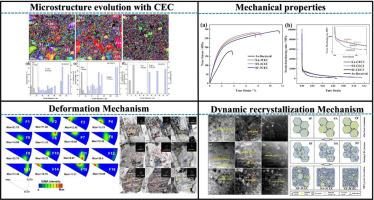调控层状LPSO相对Mg-Gd-Y-Zn-Zr合金异质组织组成及强化机制的研究
IF 13.8
1区 材料科学
Q1 METALLURGY & METALLURGICAL ENGINEERING
引用次数: 0
摘要
镁稀土合金异质结构的制备因其具有良好的强度和延展性而备受关注。然而,异质组织成分对Mg-RE合金力学性能的影响尚不清楚。在循环挤压和压缩(CEC)后,Mg-Gd-Y-Zn-Zr合金在14H长周期有序层状(LPSO)相诱导下形成了三种不同成分的异质结构。异质组织主要由动态再结晶(DRX)晶粒、变形粗晶粒、多尺度LPSO相(块状、粒状、片层状)组成。异质组织Mg-Gd-Y-Zn-Zr合金的强度和塑性同时得到提高。在CEC过程中,DRX的行为主要受层状LPSO相的影响。大间距(~ 92 nm)、低厚度(~ 13.46 nm)的片层状LPSO易于发生扭结行为,其锯齿状扭结区域可以作为促进DRX行为的成核位点。而厚度大(~ 23.41 nm)、间距相近(~ 82 nm)的片层状LPSO相则破裂为颗粒状LPSO相,从而增加了颗粒状LPSO相的体积分数,这对颗粒激发成核的DRX行为有很大贡献。固溶处理+炉冷(SF)试样在CEC过程中的主要变形机制是由基底滑移、棱柱滑移和锥体滑移组成的多重滑移。对于固溶+风冷(SA)试样和固溶+时效(ST)试样,基底滑移的激活是关键的变形机制。对屈服强度的主要贡献是晶界、位错和异质变形诱导(HDI)强化。此外,由于异质结构成分的差异,SF和SA试样在CEC变形后的HDI强度远大于ST试样。本文章由计算机程序翻译,如有差异,请以英文原文为准。

Study of heterostructure composition by regulating lamellar LPSO phase and the related strengthening mechanism in the Mg-Gd-Y-Zn-Zr alloy
The heterostructure preparation in Mg-rare earth (RE) alloy has attracted much attention due to the excellent enhancement of strength and ductility. However, the effect of heterostructure composition on mechanical properties in Mg-RE alloy is still not clear. In this work, three types of heterostructures with different composition induced by lamellar 14H long period stacking ordered (LPSO) phase were achieved in the Mg-Gd-Y-Zn-Zr alloys after cyclic extrusion and compression (CEC). The heterostructure was mainly composed of dynamic recrystallization (DRX) grains, deformed coarse grains, multiscale LPSO phase (blocky, granular, lamellar LPSO phase). The strength and ductility of Mg-Gd-Y-Zn-Zr alloy with heterostructure were simultaneously improved. The DRX behavior during CEC process was largely affected by the lamellar LPSO phase. The lamellar LPSO with large spacing (∼92 nm) and low thickness (∼13.46 nm) is easy to occur kinking behavior and the zigzag kinking area can serve as nucleation sites to promote DRX behavior. While the lamellar LPSO phase with high thickness (∼23.41 nm) and similar spacing (∼82 nm) was ruptured into granular LPSO phase and thus increase the volume fraction of granular LPSO phase, which made a great contribution to DRX behavior by particle stimulated nucleation. The main deformation mechanism of solution treatment + furnace cooling (SF) sample during CEC process is dominated by the multiple slips composed of basal slips, prismatic slips and pyramidal slips. For the solution treatment + air cooling (SA) sample and solution treatment + ageing treatment (ST) sample, the activation of basal slips is the critical deformation mechanism. The main contribution to yield strength is from the grain boundary, dislocation and hetero-deformation induced (HDI) strengthening. Moreover, the HDI strengthening in the SF and SA sample after CEC deformation is much larger than that of ST sample due to the distinct heterostructure composition.
求助全文
通过发布文献求助,成功后即可免费获取论文全文。
去求助
来源期刊

Journal of Magnesium and Alloys
Engineering-Mechanics of Materials
CiteScore
20.20
自引率
14.80%
发文量
52
审稿时长
59 days
期刊介绍:
The Journal of Magnesium and Alloys serves as a global platform for both theoretical and experimental studies in magnesium science and engineering. It welcomes submissions investigating various scientific and engineering factors impacting the metallurgy, processing, microstructure, properties, and applications of magnesium and alloys. The journal covers all aspects of magnesium and alloy research, including raw materials, alloy casting, extrusion and deformation, corrosion and surface treatment, joining and machining, simulation and modeling, microstructure evolution and mechanical properties, new alloy development, magnesium-based composites, bio-materials and energy materials, applications, and recycling.
 求助内容:
求助内容: 应助结果提醒方式:
应助结果提醒方式:


